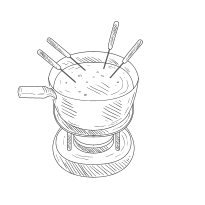Unveiling the Sweet Cascade
A chocolate fountain is a centerpiece that captivates the senses, transforming any ordinary gathering into an extraordinary affair. The sight of rich, molten chocolate cascading down tiers of delight is enough to make mouths water and hearts flutter. But have you ever paused to wonder about the mechanics behind this mesmerizing spectacle? How does a chocolate fountain defy gravity and create such a tempting flow?
The Anatomy of a Chocolate Fountain
Before delving into the workings, let’s break down the key components that make up a chocolate fountain:
1. Basin:
The basin is the foundation of the fountain, typically made of stainless steel or polycarbonate. It holds the melted chocolate, acting as a reservoir for the cascading goodness.
2. Heating Element:
Hidden beneath the basin lies a heating element responsible for maintaining the chocolate at the perfect consistency for flowing. The temperature is crucial, ensuring the chocolate remains melted without burning or solidifying.
3. Auger:
The auger is a spiral-shaped mechanism located within the fountain’s central cylinder. It plays a pivotal role in propelling the chocolate upwards, defying gravity and setting the stage for the cascading effect.
4. Tiers:
Stacked above the basin, the tiers are what give the fountain its height and elegance. Chocolate flows over the edges of each tier, creating the mesmerizing cascade that is both visually appealing and utterly irresistible.
The Science of the Flow
The secret to a chocolate fountain’s mesmerizing flow lies in the perfect interplay of physics and engineering. Here’s a step-by-step breakdown of the process:
1. Melting Majesty:
The journey begins with melting the chocolate, a process that requires precision and care. Chocolate must be melted slowly and evenly to achieve the ideal consistency. Using a double boiler or a microwave on a low setting prevents scorching and maintains the chocolate’s smooth texture.
2. Upward Journey:
Once the chocolate is melted, it is poured into the basin of the fountain. The heating element beneath the basin keeps the chocolate in a liquid state, while the auger, the heart of the fountain, comes into play.
3. Auger’s Ascent:
The auger, powered by an electric motor, rotates slowly within the central cylinder. As it rotates, its spiral grooves draw the melted chocolate from the basin upwards. Think of it as an escalator for liquid chocolate, propelling it towards the top tier.
4. Cascading Wonder:
When the chocolate reaches the top tier, it overflows and gracefully cascades down to the tiers below. The shape and design of the tiers, often resembling a gentle waterfall or a series of overlapping bowls, enhance the flow and create the mesmerizing spectacle.
5. Continuous Delight:
As the chocolate descends, gravity takes over, guiding it back into the basin. The cycle then repeats, with the auger continuously drawing the chocolate upwards, ensuring a perpetual flow of chocolaty goodness.
Choosing the Right Chocolate
Not all chocolate is created equal when it comes to chocolate fountains. The type of chocolate used significantly impacts the fountain’s performance and the overall taste experience.
1. Couverture Chocolate:
Couverture chocolate, with its higher cocoa butter content, is the gold standard for chocolate fountains. It melts smoothly, flows beautifully, and delivers a rich, decadent flavor.
2. Milk Chocolate and Dark Chocolate:
While couverture chocolate reigns supreme, milk chocolate and dark chocolate can also be used, adding variety and catering to different palates.
3. Adding Oil (Optional):
If you’re using chocolate with a lower cocoa butter content, adding a small amount of vegetable oil can improve its flow and prevent it from solidifying too quickly. However, use oil sparingly, as too much can compromise the chocolate’s flavor and texture.
Tips for a Successful Chocolate Fountain Experience
To ensure a flawless and delightful chocolate fountain experience, keep these tips in mind:
1. Proper Preparation:
Thoroughly clean and dry all fountain parts before use to prevent chocolate from sticking and to ensure smooth operation.
2. Temperature Control:
Monitor the chocolate’s temperature throughout the event to maintain its ideal consistency. Most fountains have adjustable temperature settings, allowing you to fine-tune the flow.
3. Dipping Delights:
Offer a variety of dipping treats to accompany the chocolate cascade, such as fresh fruit, marshmallows, pretzels, and cookies. The options are endless, limited only by your imagination.
4. Mindful Dipping:
Encourage guests to use skewers or fondue forks for dipping to prevent double-dipping and maintain hygiene.
5. Post-Fountain Cleanup:
While cleaning a chocolate fountain might seem daunting, it’s manageable with the right approach. Most parts are dishwasher safe, and any remaining chocolate can be easily removed with warm, soapy water.
Conclusion
A chocolate fountain is more than just a dessert; it’s an experience, a conversation starter, and a centerpiece that sparks joy and indulgence. By understanding the mechanics behind its mesmerizing cascade, you can appreciate the artistry and engineering that transforms ordinary chocolate into an extraordinary delight. So, the next time you encounter a chocolate fountain, take a moment to marvel at the sweet science at play. And then, of course, indulge in its irresistible allure.

